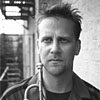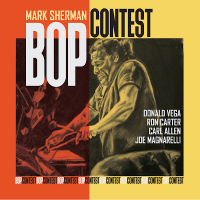Home » Jazz Articles » Swing Set » Lionel Hampton: "Flying Home"
Lionel Hampton: "Flying Home"
 In his autobiography Malcolm X described the first time he heard "Flying Home. "People kept shouting for Hamp's "Flying Home and finally he did it. I had never seen such fever heated dancing. In his autobiography, Lionel Hampton tells the story of the time at the Apollo when a guy who had smoked too much marijuana launched himself from the second balcony when the band played the song, apparently in the mistaken belief that he could "fly home. In fact, Hampton's hottest number had such a reputation for whipping crowds up into a frenzy that one time in Connecticut police forbade him from playing it for fear that the balcony would collapse. And all this on the vibes, an instrument that is considered one of the lightweights on the bandstand, and one that continues to have a marginal presence in jazz even today.
In his autobiography Malcolm X described the first time he heard "Flying Home. "People kept shouting for Hamp's "Flying Home and finally he did it. I had never seen such fever heated dancing. In his autobiography, Lionel Hampton tells the story of the time at the Apollo when a guy who had smoked too much marijuana launched himself from the second balcony when the band played the song, apparently in the mistaken belief that he could "fly home. In fact, Hampton's hottest number had such a reputation for whipping crowds up into a frenzy that one time in Connecticut police forbade him from playing it for fear that the balcony would collapse. And all this on the vibes, an instrument that is considered one of the lightweights on the bandstand, and one that continues to have a marginal presence in jazz even today.
A New Vibe
Hampton started out as a drummer, but came upon the vibes by chance at a Louis Armstrong date in 1930. Invented ten years earlier, the virbaharp is essentially a xylophone with metal resonators equipped with electric-powered fans that that added vibrato. In the Okeh recording studio a set sat in the corner. Armstrong asks Hampton what they were, and he replied that they were a new percussion instrument that at the time was only being used on the air for radio tones, like the three-note NBC call sign. Armstrong asked Hampton to give it a whirl on the Eubie Blake tune "Memories Of You which became the first time the vibes had been used on a jazz recording. Hampton's wife Gladys convinced him that it would be the instrument that would lead him to fame. Later on, of course, it was the instrument that Hampton pioneered in a jazz context, paving the way for Milt Jackson, Bobby Hutcherson, and others.
Flying Home

"Flying Home had its genesis while Hampton was in the Benny Goodman band. A gig in 1939 required them to fly from Los Angeles to Atlantic City, the first time Hampton had been on a plane. He began whistling a tune while waiting for the plane to taxi. Goodman asked him what it was, and Hampton said, "I don't know. We can call it 'Flying Home,' I guess. (Hampton later confessed that the tune was a way for him to keep his mind off of the upcoming flight.) They played it for the first time with the Goodman Quartet that night and later that year Goodman recorded the first version of the song, featuring a memorable solo from pioneering guitarist Charlie Christian. Hampton liked the song so much that it became his theme once he left Goodman.
 Hampton always saw his role as an entertainer first and a musician second. His uncontainable energy and fiery tunes like "Flying Home made him popular with crowds and anticipated the showmanship that would dominate popular music a few decades later.
Hampton always saw his role as an entertainer first and a musician second. His uncontainable energy and fiery tunes like "Flying Home made him popular with crowds and anticipated the showmanship that would dominate popular music a few decades later.
Although Hampton first recorded "Flying Home under his own name with a small group in 1940 for Victor, the best and most famous version is the big band version recorded for Decca on May 26, 1942 in a new arrangement by Hampton's pianist Milt Buckner. After a brief vibes introduction, punchy riffs from the saxophone section introduce the main theme. Soon after, Illinois Jacquet swoops in on tenor sax for the longest solo on the record. He builds on a series of variations on the main theme, before heating things up with a single note phrase while the trombones fan the flames underneath. It was a celebrated solo that was a tour de force in honking and wailing and served as the template for almost every R&B saxophonist that followed in his footsteps. It also marked the emergence of Jacquet as a new star who went on to join Cab Calloway before becoming one of the first artists signed to the Blue Note label.
Like many of the high-powered riff tunes of the time, "Flying Home doesn't disappoint when it builds to a climax. Hampton plays bursts of riffs followed by trumpet blasts from Ernie Royal that increase in pitch and intensity. Finally, with a thunderous crescendo, the band riffs out.
The Big Finish
 "Flying Home was the single that cemented Hampton's popularity as a bandleader, but the record gave little indication of what the song would become live. On stage it often lasted 20 minutes in length, and featured plenty of high-powered soloing from the bandstand, not least of all from Hampton who made an unlikely instrument swing. Due to its notoriety as a song that could whip crowds into a frenzy like Goodman had done a few years back with "Sing, Sing, Sing, other bandleaders soon incorporated the catchy tune into their program. Once the LP era hit, Hampton was able to record full-length versions of the tune that often dominated one side of a record. Hampton outlived many of his contemporaries, continuing to play "Flying Home as his signature tune up until the end of the twentieth century. Although not a creative force like Ellington or Basie, Hampton nevertheless brought his distinctive energy and enthusiasm to his work and created some of the more memorable records of the Swing Era.
"Flying Home was the single that cemented Hampton's popularity as a bandleader, but the record gave little indication of what the song would become live. On stage it often lasted 20 minutes in length, and featured plenty of high-powered soloing from the bandstand, not least of all from Hampton who made an unlikely instrument swing. Due to its notoriety as a song that could whip crowds into a frenzy like Goodman had done a few years back with "Sing, Sing, Sing, other bandleaders soon incorporated the catchy tune into their program. Once the LP era hit, Hampton was able to record full-length versions of the tune that often dominated one side of a record. Hampton outlived many of his contemporaries, continuing to play "Flying Home as his signature tune up until the end of the twentieth century. Although not a creative force like Ellington or Basie, Hampton nevertheless brought his distinctive energy and enthusiasm to his work and created some of the more memorable records of the Swing Era.
Sources
Hampton, Lionel with James Haskins. Hamp: An Autobiography. New York: Amistad Press, 1993.
Schuller, Gunther. The Swing Era. New York: Oxford University Press, 1989.
The Swing Era: 1941-1942. Jay Gold, ed. New York: Time Life Records, 1970.
Tags
PREVIOUS / NEXT
Support All About Jazz
 All About Jazz has been a pillar of jazz since 1995, championing it as an art form and, more importantly, supporting the musicians who make it. Our enduring commitment has made "AAJ" one of the most culturally important websites of its kind, read by hundreds of thousands of fans, musicians and industry figures every month.
All About Jazz has been a pillar of jazz since 1995, championing it as an art form and, more importantly, supporting the musicians who make it. Our enduring commitment has made "AAJ" one of the most culturally important websites of its kind, read by hundreds of thousands of fans, musicians and industry figures every month.





















